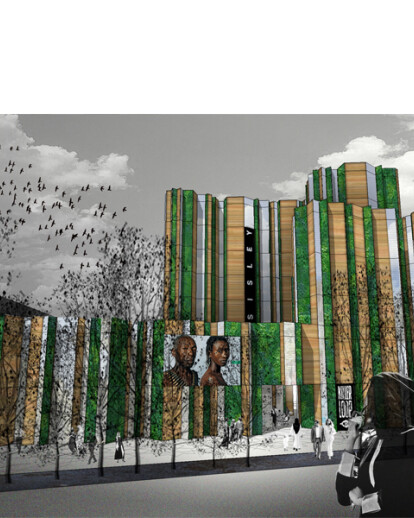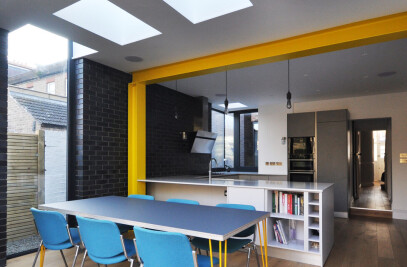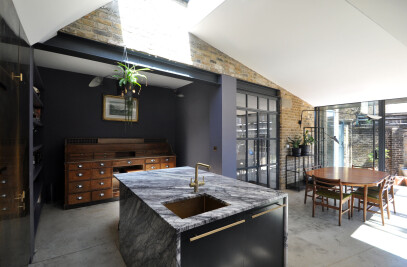COMPOSITION The composition is based on the ‘Umm Al-Girih’ – an infinite Islamic pattern made up by five contiguous polygons (decagon, pentagon, diamond, bowtie and hexagon). This assembly has been scaled from its more conventional size to conform and influence the layout spreading out over the entire site and beyond the boundaries into the public realm.
The building facade is an extrusion of the floor pattern into the third dimension and appears to follow a random outline of infinite options however the de-constructive manifestation of the cladding is inherently influenced by the required floor areas, zones, circulation and structure. The arrangement of the volumes is determined by the orientation both towards the sun and the busy street.
An opening in the front facade provides a passage, lined by shop windows, to a courtyard. From there one can enter the third shop and the office reception. The entrance to the residential lift lobby is discretely located at the back of the building. Access to the underground car park is provided via the more secure side street. Over ground parking has been omitted in favour for the courtyard and the shape of the building, however, the occasional cut backs within the facade can be used as dropping-off points, loading bays and in a case of emergency.
The structure derives from the logic of the system through the occasionally appearing star pattern which is made up by the decagon and diamond arrangement. The stars follow a ‘hidden’ grid and replace conventional cores. The pattern’s overall influence becomes more evident and expressive in detail. This is apparent through the external and internal floor treatment and also in the suspended ceilings of the commercial parts, which are defined by its layout.
ENVELOPE
There are three cladding types which whilst dealing with the environmental conditions also serve to emphasise the variation of the extruded plan into the facades. All of them are ‘unitised’ curtain wall systems. One is pre-glazed with fritted or clear double glazed units, one is an insulated panel with vertical planting in front of it and one is filled with rammed earth. All panels are a storey high and vary in width to follow the pattern. Each panel front is flush to its neighbouring with recessed rubber gaskets between them. All frame work is made of black anodised aluminium extrusions which are designed as such that adjoining panels build a mitred corner.
SUSTAINABILTY
Thanks to the overall thermal mass, the properties of the rammed earth, the ‘intelligent’ glass and the integral natural ventilation the building has no need for an air condition system and a reduced requirement for heating. The amount of planting has a direct positive impact on the surrounding area. Further to that most of the building’s materials are recyclable.
‘SERVICE STARS’
These mini-cores do not only carry the load of the floors above they also contain the service and natural ventilation shafts and have functions such as staircases, lifts, toilets, bathrooms, changing rooms, small offices and meeting rooms at their centre. Once above the finished roof level they form planters, benches and parts of cooling towers. The massive columns are made up by re-enforced rammed earth adding thermal mass and reducing the need for concrete to the floor slabs and the levels below ground only. The solidity and mass of the structure adds positive aspects towards the resistance against earth quakes.
NATURAL VENTILATION
In historical Islamic cities the architecture has provided a ventilation and cooling system called ’Al Malqaf’ (Badgir). This system consists in a tower that cuts through and rises above the houses. The tower serves to catch the outside air that flows through it towards the building’s rooms.
A similar principle is applied here: A hollow diamond shaped column is internally divided into two halves. One is letting cool air down which has been ‘caught’ on the roof terrace whereas the other one is allowing hot air to escape upwards from the commercial areas.
STUD WALLS
In order to enhance the sustainable aspects of the office environment further, conventional stud walls are being replaced with 200mm thick rammed earth walls. This adds further thermal mass and allows for a natural control of the humidity. It is easy to allow for recessed service runs on both sides within the wall build up due to its thickness. Rammed earth is also not flammable by default.

































